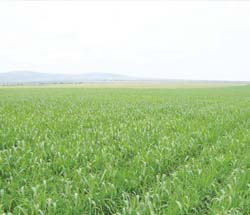Powdery Mildew in Cereal Crops
 Powdery mildew, caused by the fungus Blumeria graminis, is one of the most common and damaging foliar diseases in wheat. Powdery mildew exists almost everywhere wheat is grown. As an obligate parasite, the fungus grows only on living tissue.
Powdery mildew, caused by the fungus Blumeria graminis, is one of the most common and damaging foliar diseases in wheat. Powdery mildew exists almost everywhere wheat is grown. As an obligate parasite, the fungus grows only on living tissue.
Powdery mildew is particularly a problem in regions with high nitrogen fertilization and high stand densities. Cool, moist weather conditions with high relative humidity – 97 to 100 percent – enhance germination of the fungal infection. Optimum temperatures for development of powdery mildew are 59 to 70 degrees F, typically making it the first leaf disease of the season. When temperatures climb above 77 degrees F, powdery mildew begins to deteriorate.
Powdery mildew is characterized by white, cottony patches (colonies) of mycelium and conidia (asexual spores) on the surface of the plant. They can occur on all aerial parts of the plant, including stems and heads, but are most conspicuous on the upper surfaces of lower leaves. The white colonies later turn dull gray-brown.
Identification and Lifecycle Symptoms of powdery mildew are white, cottony patches (colonies of mycelium) and asexual spores (conidia) on the surface of the wheat plant. Although the white patches can occur on all aerial parts of the plant, including stems and heads, they are most easily visible on the upper surfaces of lower leaves.
Later, the white colonies or patches turn dull gray to gray-brown in color. Severe infections can result in wheat plant stunting. Heads on the later tillers may show more heavy infection because they reside lower in the wheat canopy, where humidity remains high. The leaf tissue on the opposite side of the white mold growth turns yellow and then changes to tan or brown.
As plants mature, small, distinct black dots containing spores develop on plant leaves. In this phase of the disease, spores reside in older, gray-colored powdery mildew colonies that infect the wheat field.
Typically, the lifecycle of powdery mildew begins after wheat planting. The fungus overwinters on straw residue as white, cottony patches of asexual spores. Spring infections occur when spores are dispersed by wind and rain.
As the major cause of powdery mildew, these spores are produced in large numbers from initial infections.
Windborne spores land on plant surfaces and germinate, resulting in new infections on healthy plants or secondary infections on plants already infected. New spores can reproduce in seven to 10 days. The fungus can spread throughout the growing season, especially on susceptible varieties infected in early spring and when weather conditions are favourable.
Crop Damage
The greatest yield loss occurs when the flag leaf of a wheat plant becomes severely diseased by powdery mildew by the time of heading. Damage caused by the powdery mildew fungus increases the number of non-productive tillers, resulting in yield loss even at low levels of infection.
Disease infection robs yield by reducing kernel size, number of seeds per unit area and test weight. A rule of thumb is the earlier a spring mildew infection begins and the higher up the plant it spreads by flowering, the greater the resulting yield loss. According to research, wheat yield losses from powdery mildew may be as high as 45 percent.
Managing Powdery Mildew
Farmers have to consider several components of their management strategy for powdery mildew on wheat, including seed treatments, variety selection, scouting, cultural practices and fungicide applications.
Variety selection
Every commercially available wheat variety has a unique disease package, and excellent disease resistance is not available to manage all disease threats in high-yielding varieties. It’s best to select two or three high-yielding varieties that offer the best resistance to common diseases found on your individual farm.
Scouting
When scouting for weeds and insects, check for the presence of powdery mildew and other leaf diseases. Scouting helps you make the best decision about whether or not a fungicide application is needed, and it also provides information to help you select appropriate disease management practices for future crops. If you suspect powdery mildew, take samples and work with your county Extension agent to confirm a diagnosis. Crop identification guides are also helpful.
Cultural practices
Crop rotation can help deter diseases. In areas where continuous wheat is grown, cultivation can break down crop residue that harbours certain diseases. Plant disease-free seed. Good weed control from preplant, at planting and throughout the growing season also helps protect against disease and other pests.
Fungicides
Excellent powdery mildew control can be achieved with commercially available fungicides. The decision to use fungicides should be based on scouting for symptoms. It’s important to assess disease severity from the growth stages of tiller elongation through flowering. Experts recommend application timing to keep the upper leaves of the wheat plant disease-free, allowing full potential for grain fill. Other factors affecting fungicide application are infection levels in the field, the susceptibility of the variety and the market price for wheat grain.